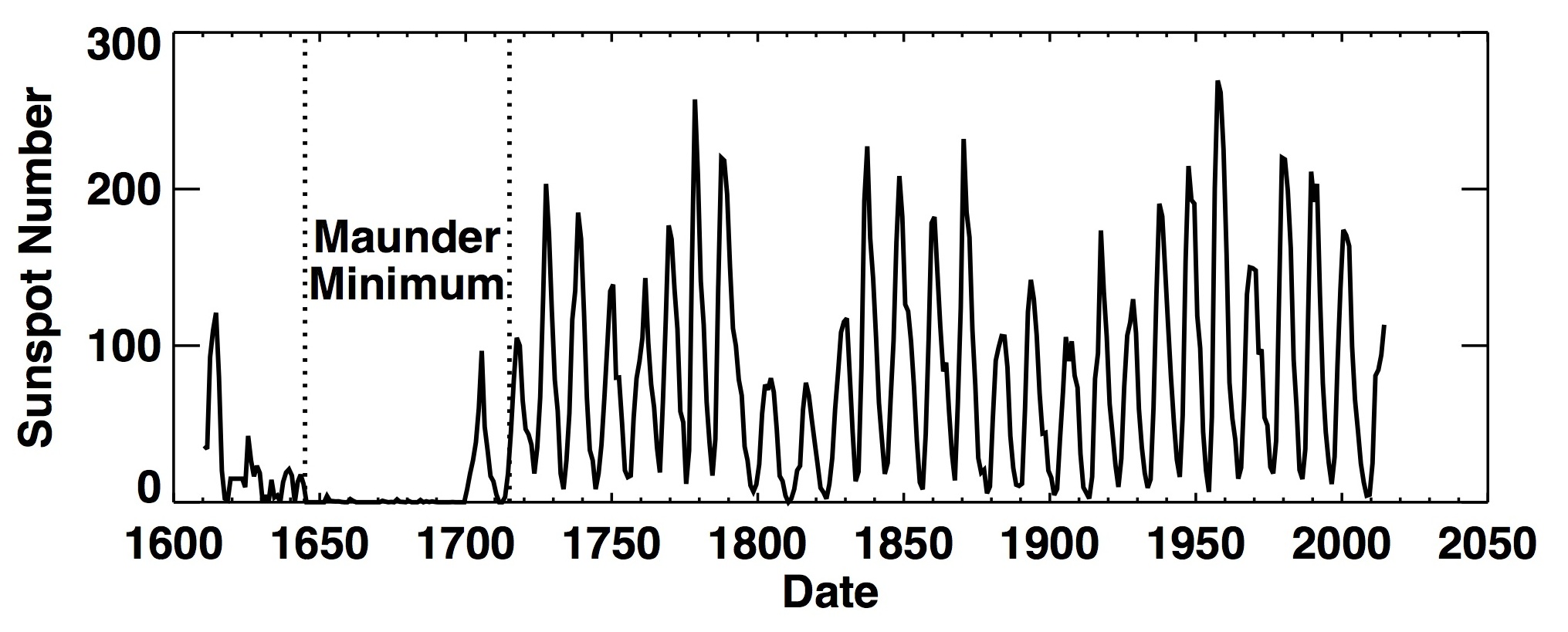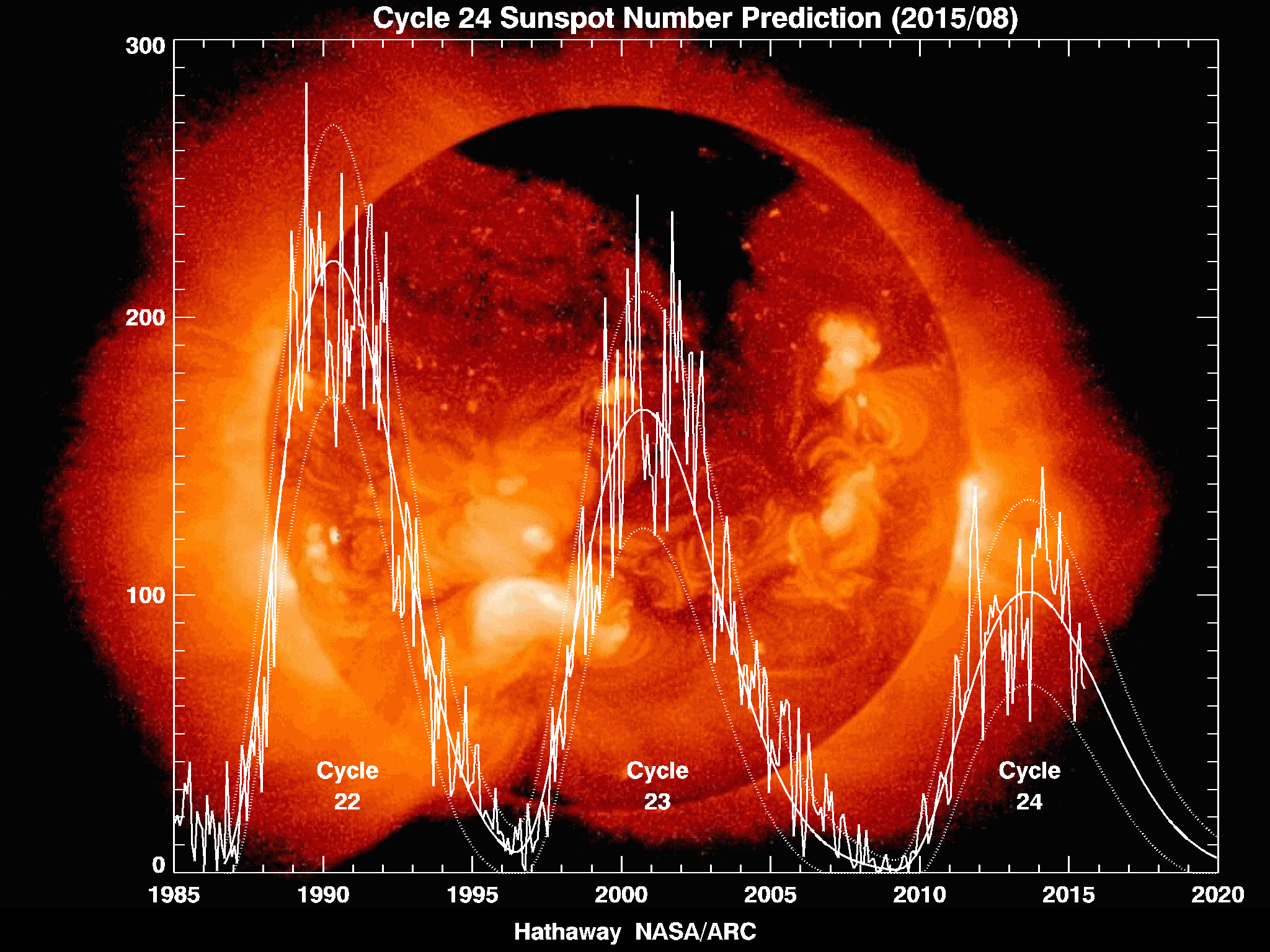I’ve reached the halfway point through my Introduction to Astronomy class. This week marks the eighth week of fifteen, sixteen if you count the first week where we just spent time getting to know each other and exploring the textbook and getting the lab software, Starry Night, installed and licensed. Last week, we reached the outer limits in the Kuiper Belt and Oort Cloud of our solar system where only comets and Voyagers I and II have ventured. Now we’ve snapped back to study our closest star, Sol, or more commonly just the Sun. My topic for discussion responds to the following question:
Why is the solar cycle said to have a period of 22 years, even though the sunspot cycle is only 11 years long?
Some surface features on our active Sun vary periodically in an eleven year cycle. The Sun’s magnetic fields which cause the surface changes vary over a twenty-two year cycle. The relatively cool and slightly darker regions, commonly called sunspots, are produced by local concentrations of the Sun’s magnetic field piercing the photosphere. The latitude and number of sunspots on average vary during the same eleven year cycle. But the hemisphere where the Sun’s north magnetic pole anchors during one eleven year cycle will have south magnetic poles during the next. Because it takes a full twenty-two years for the magnetic poles to return to their original orientation astronomers refer to the entire solar cycle. The magnetic dynamo model posits that many transient features of the solar cycle are caused by the effect of differential rotation and convection on the Sun’s magnetic field. The Sun’s differential rotation (different speeds at different latitudes) causes its magnetic field to become increasingly stretched like a rubber band. The bands can’t break so they periodically untangle themselves with the help of trapped gases which leak out (sunspot) and gradually settle back under the photosphere, when the sunspot disappears. The most recent reversal of the Sun’s magnetic field occurred in 2013. We are currently at the tale end of Solar Cycle 24. (Comins, 2015, p. 272-83)
From the NASA Solar Cycle Primer:

The sunspot cycle happens because of this pole flip — north becomes south and south becomes north—approximately every 11 years. Some 11 years later, the poles reverse again back to where they started, making the full solar cycle actually a 22-year phenomenon. The sun behaves similarly over the course of each 11-year cycle no matter which pole is on top, however, so this shorter cycle tends to receive more attention. (Fox, 2011)
Trends and Predictions:
 In 1893, British astronomy E. Walter Maunder compiled historical observations to conclude that no sunspots occurred from 1645 through 1715 (now commonly referred to as the Maunder minimum) and coincided with a period of cold so extreme in Europe it is now known as the Little Ice Age. Back home here in North America, a severe drought occurred during that time frame. (Comins, 2015, p. 279)
In 1893, British astronomy E. Walter Maunder compiled historical observations to conclude that no sunspots occurred from 1645 through 1715 (now commonly referred to as the Maunder minimum) and coincided with a period of cold so extreme in Europe it is now known as the Little Ice Age. Back home here in North America, a severe drought occurred during that time frame. (Comins, 2015, p. 279)

By Cycle 25 or 26, magnetic fields may be too weak to punch through the solar surface and form recognizable sunspots at all, spelling the end of the sunspot cycle phenomenon, and the start of another Maunder Minimum cooling period perhaps lasting until 2100. (Odenwald, 2016)
Affect on Radio Frequencies:
I spent a lot of time during the 70s tagging along with my dad on his amateur radio adventures – installing repeater antenna towers, attending convents (colloquially called ‘ham fests’) – or just hanging out with him in his shack while he soldered up a circuit board, tested vacuum tubes and used his oscilloscope for other tests. By the time I was twelve, I too was inducted into the amateur radio ranks and received my license after studying and taking the test. Even before I owned a telescope, I knew that sunspot activity affected certain bands available for use by amateur radio operators.
. . . with more solar activity comes more magnetically-driven sunspots, and with more sunspots comes more UV radiation to the earth’s atmosphere. The increased UV creates more ions, increasing the density of the ionosphere layers. And when the ionosphere is dense with ions the bending effects on RF signals is increased. And the greater the bending effect, the higher the RF frequencies that will get directed back toward earth, opening the higher frequency bands for our amateur radio use! (Turner, 2016)
The higher HF bands (10m – 17m) will be most effective for skip propagation during the solar maximum, which peaked back in 2013. Some of these higher HF bands may not be open during the lower activity portions of the solar cycle (like now).
References
Comins, N. F. (2015). Chapter 9 The Sun: Our Extraordinary Ordinary Star. In Discovering the essential universe (6th ed., pp. 267-292). New York, NY: W.H. Freeman and Company.
Fox, K. C. (2011, October 27). Solar Cycle Primer | NASA. Retrieved from https://www.nasa.gov/mission_pages/sunearth/news/solarcycle-primer.html
Hathaway, D. (2015, March 15). NASA/Marshall Solar Physics. Retrieved from https://solarscience.msfc.nasa.gov/SunspotCycle.shtml
Odenwald, S. (2016, September 2). Waiting For The Next Sunspot Cycle: 2019-2030 | HuffPost. Retrieved from https://www.huffingtonpost.com/dr-sten-odenwald/waiting-for-the-next-suns_b_11812282.html
Turner, S. (2016). Sunspots and Propagation – Ham Radio School.com. Retrieved from http://www.hamradioschool.com/sunspots-and-propagation/

